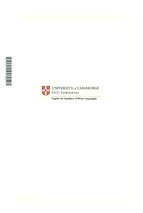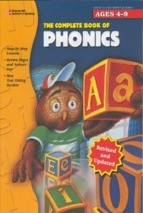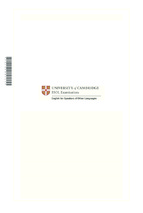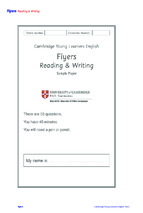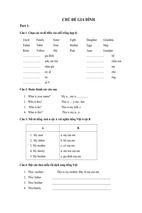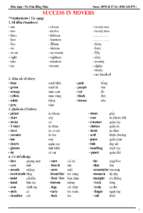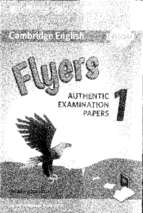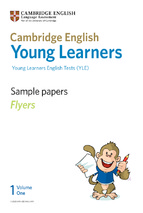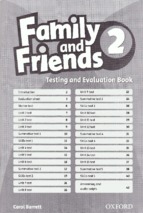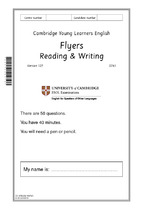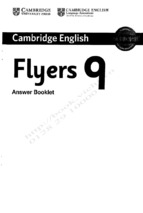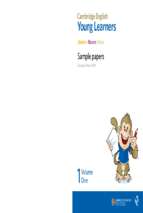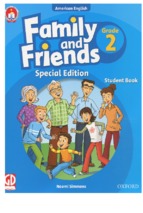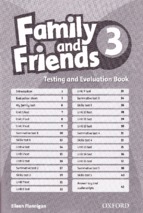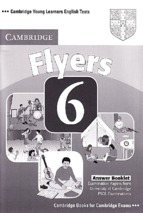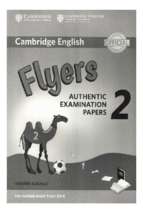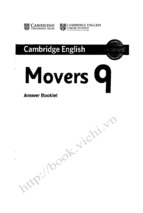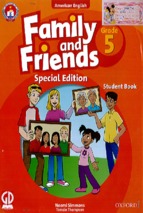Contents
'
,
~';:I1e:Sson'
Introduction to the Teacher's Guide
List of Games
List of Flashcards
Classroom Language
Welcome: A great adventure l
1 Where's Toto?
2 We're getting readyl
Topic/Vocabulary- , '
~
~~
""
detective, missing
clever, niece, nephew, friendly, helpful
laptop, binoculars, compass, can opener, need,
diary, torch
well, carefully, badly, slowly, quietly,
happily, quickly
- "'
Lang-uage
-
"
Present simple
4 Skills: Let's phone Mel,
flyHigh File: Countries
and nationalities
country, capital city, flag, nationality, language
storm, behind, windy, thunder and lightning,
in front of
aquarium, town hall, police station, pet shop,
museum, cafe
notice, blond, moustache, beard, thin, wavy, face
5 There was a storm
6 We landed on a beach,
7 Did you talk to them?
8 Skills: I'd like tickets for the
museum, please,
hurricane, last, flood, cause, tornado, produce,
travel, destroy, natural disaster
flyHigh File: Hurricanes
Present continuous
8
Adverbs of manner
10
Functional language: saying your
phone number
Writing Class: punctuation
3 Dr Wild drives well,
12
Present simple; present continuous
14
There was/were/wasn't/weren't
16
Past simple regular: affirmative
18
Past simple regular: negatives and questions
Functional language: asking for tickets
Writing Class: and and but
20
Present simple; pastsimple
The flyHigh Review 1
9 Magnus and Claudia had an accident l
10 Did they find Toto?
scared, confused, nervous, unhappy
11 Claudia couldn't hear,
well, cold, headache, sore throat, earache,
ill stomachache
Storytime: Robinson Crusoe
12 Skills: I'm sorry I couldn't come,
FlyHigh File: Dinosaurs
continent, plant, lizard, land, sea, sky
13 -"eywent through the town,
train station, road, market, castle, bridge
14 ;-. 0 0'. ;nuch were the tickets?
money, seat, search, carriage, look after, luggage
somethingI
stew, rice, cabbage, steak, peas
.- - --. .- <=- c:"' ::JS
- -_: - :..:
- - - - .=.
~
art gallery, cathedral, church, tower, Big Wheel,
bell, bridge, hill, street
=5:our
_
;; Is ::,cu:3-
----
24
28
Past simple irregular: affirmative
Past simple irregular: negatives
and questions
30
could/couldn't
34
Functional language: giving reasons and
describing what you have done
Writing Class: on, in, atwith days and times
Past simple; could/couldn't
Prepositions of movement: along, past,
across, around, through
Quantifiers: much, many, a lot of, a little, a few
somebody/anybody/nobody/something/
anything/nothing
Functional language: saying what you would
like to eat and drink
32
36
38
40
42
44
46
Writing Class: first, then, afterwards, finally
-""e ! L
"!';''';'; =' .; ?t'. '=W =-=- , ~.[=" ~'.i:n:=""rcr.c
- J '.........
---
18
22
26
ill, tool, gun, knife,journey, land, island, tent, cave,
strange, footprint
farm, cow, grass, owl, pond, bull
- : - __ '0
Page
i
vi
viii
ix
4
6
----------
19 Dr Wlla ver: iO :-e :x;-,:c
some money.
20 Skills: I arrive at twenty
to nine.
hare, place, wine, tea, polite, wide, angrily
rescue, scarf, glove,jacket, belt, trainers, tie
arrive, leave, start, lose, bring, finish
~a;
bank, post office, send, find, garage, hire
Past simple
Possessive pronouns
have to/don't have to
has to/doesn't have to
48
50
52
54
56
Infinitives of purpose
58
Functional language saying the time
Writing Class: writing the time
60
·
lesson
...
u'
:>lT~piclVocabulary,,,
,u
".
>"'~h
_
,,'!,
4..,.JU
~~;;.\tpL'..iY~ .. ~{~.languageC}~~"~~n~'\l\". ~~,Page~!SJt
Ordinal numbers: 77th to 27st
breeches, cap, trainers, tunic, apron
van, motorbike, fire engine, scooter, helicopter
Past simple
62
Comparatives with -er
64
silly, catch, runner, noisy, light
Superlatives with -est
66
23 Oscar has got the most
comfortable bed l
expensive, soft, comfortable, modern,
dangerous, exciting, tobogganing
24 Skills: Which bike do you
like best?
wheel, gears, handle bars, brake, saddle
flyHigh File: Planets
planet, rock, ring, gas, star, ice, furthest
Comparatives and superlatives with more
and the most
Functional language: comparing
different items
Writing Class: adjective order
Present simple; comparatives and
superlatives
flyHigh File: Clothes through the ages
21 The red van is faster l
22 They are the silliest people
in the world l
I
The F1yHigh Review 3
Storytime: The Prince and the Pauper
25 Iwanttojoin in,
68
70
72
74
palace, poor, beg, gates, soldiers, beggar, rich,
servant, cheap, pauper
join in, fancy dress, costume, alien, superhero,
pop star
76
want to + infinitive
78
26 He likes tobogganingl
ice skating, surfing, skateboarding, rock climbing,
cycling, fishing
like + -ing
be good at + -ing
I'm happy when I'm , , ing
80
27 What shall we do?
use, escape, reach, borrow, hold
Shall we ", ?
What about, , , ing?
82
28 Skills: Shall we meet in the park or at
my house?
flyHigh Fi le: Sporting legends
29 I'm going to phone the police l
30 Are they going to come home now?
31 Why did they want Toto?
football player, goal, score, world record, Olympic
flag, gold medal, medicine, compete, train
knock over, lamp, curtain, rug, sofa,
cushion, prison
plan, picnic, invitation, banner
rare, robber, steal,jewellery, valuable,
painting, diamond
.
34 Have you seen these photos?
35 I haven't brushed Oscar yeti
88
Future: negatives and question with going to
90
Why? Because
92
94
award, physical, volunteering, skills, expedition,
photography, sewing, knitting, OJ
96
98
sailor, voyage, dangerous, captain, ship, sail,
wood, afraid
disappear, explain, return, hot air balloon, trip
horse riding, camping, canoeing, Chinese,
restaurant
brush, polish, change
36 Skills: You should take your camera,
f lyHigh File: The Arctic and Antarctic
North Pole, South Pole, Arctic, Antarctic, scientist,
light, dark, polar bear, walrus, seal, fox,
whale, penguin
Goodbye: Party time l
'1e FlyHigh Review 5
'1e FlyHigh Show: The amazing
adventure l
l
eacher's Day
/alentine's Day
'1e Queen's Birthday
~ctivity Book Answer Key
':'Jdioscripts
_esson -by-L
esson Word List
86
F
uture: affirmative with going to
- he FlyHigh Review 4
Storytime: The Voyages of Sindbad
the Sailor
33 Jack has disappeared l
84
Functional language: inviting someone
to a party
Writing Class: writing dates
32 Skills: Would you like to come to
our party?
flyHigh File: Duke of Edinburgh's Award
Functional language: making arrangements
Writing Class: using orin questions
Present simple; past simple; comparatives
and superlatives
100
Present perfect: affirmative (recent eventsl
Present perfect: negatives and questions
(life experiencesl
Present perfect with yet
Functional language: giving advice with
should/shouldn't
Writing Class: writing an address
Present simple; comparatives
and superlatives
102
104
106
108
110
112
114
116
Ancient Greece, wax, stick, wrestling, strict, hit
message, rose, violet, heart
gun salute, garden, midday, parade
118
1
20
122
1
24
1
34
140
Introduction
Fly High is a motivating and charismatic four-level course for
young learners aged between 6 and 10. It is intended for children
who are being taught at a faster pace, and aims to give them
a sound base in English and to maximize their potential by
providing the appropriate level of support and challenge.
While progressing through the Fly High course, young learners
will build up a solid bank of useful vocabulary and the ability
to apply grammatical structures appropriately. They will
also develop and refine their reading, writing, speaking and
listening skills.
Fly High is based on the principle that children learn best
when they are using engaging materials that appeal to their
imagination and build their confidence. Familiarity with a group
of characters, which the children get to know as the course
progresses, combined with the element of fun that runs through
the course, ensure that the children enjoy, and thus remember,
the language they are learning. The wide variety of activities
caters for children with different learning styles: visual, auditory,
kinaesthetic, musical and interpersonal.
Fly High 4 is for children who have achieved a good level of
English, and provides the appropriate level of challenge. Longer
and more varied reading texts cover broad themes relevant to
the interests of the age group. Activity types are more demanding
and there is a greater emphasis on accuracy.
On completion of Fly High 4, children will have attained
communication competencies up to level A2 of the Council
of Europe's Common European Framework for Modern
Languages (CEFI.
Methodology
Structure of the Course
Fly High 4 features an exciting new adventure story, introducing
Dr Wild, an animal detective, her nephew Jack and niece Kelly,
and their school friends Mel, Beth, Harry and Kit. Dr Wild, Jack
and Kelly set off to find Toto, a toucan which has gone missing
from the zoo. The Pupil's Book is organized into nine Cycles. Each
Cycle in the Pupil's Book presents a new episode in the search for
Toto and covers a particular area of grammar.
Language presentation
Key words and target grammar items are introduced in the
context of the story, which is presented using a variety of formats:
play scripts and continuous texts as well as a cartoon strip. New
vocabulary is presented at the beginning of a lesson through a
picture dictionary. The new words are recorded so that children
can hear and repeat them . Through the story, children get
to know the characters and engage with the search for Toto,
and can try to guess what happens next. There is also ample
opportunity to recycle language by eliciting what has happened
in previous episodes.
Grammar
Grammar items are always introduced in the context of the story.
The target grammar is then presented clearly in the Learn with
Oscar box and the meaning reinforced by means of examples
and humorous cartoons. Children can refer to the examples to
help them with the exercises that follow.
Language practice
A wide variety of practice exercises enable the teacher to change
pace and keep children interested and engaged. They also
cater for different learning styles. Interaction patterns are varied,
allowing for individual work, pair work, group work and wholeclass modes of learning . Every Cycle contains communicative
activities and a song to activate the language. The Teacher's
notes often provide ideas for games and there is also a list of
classroom games on page vii of this Introduction.
Songs
Singing songs helps to build confidence in the language through
repetition, and promotes musical skills and development
of rhythm. Every Cycle in Fly High 4 has a song, often with
accompanying actions, which also supports kinaesthetic learners.
At this level, all songs have an accompanying task, ego filling the
gaps or circling the correct word.
~~
detective
A great adventure!
missing
v
Objective: introduce the setting and the main
characters of the book
Vocabulary: detective, missing
Grammar: He//o l Hifname/. They're .... She's....
Materials: Class CD
Warm-up
•
Say Hello boys and girls. Welcome to Fly High 4. My name
is (your name/.
• Go round the class asking children What's your name?
Then say Hello (child's name} to each child. Ask the children
to turn to their partner and say Hello (partner's name/.
• Tell the children they are going to meet some new
characters in Fly High 4 and that they are going to find out
their names.
A great adventure! ~' 1
•
•
•
•
•
CD Match.
Track02
Say Open your book at page 4. Open your own book and
. hold it up to demonstrate. Ask the children to look at the
pictures on page 4. Ask individual children to tell you what
they can see in the picture, e.g . boy, girl, woman, cat
computer. Write the words on the board.
Point to the words one at a time and ask the children to
call them out.
Play the CD and ask the children to follow with their fingers
as they listen.
Play the CD again. Pause after every person and ask the
children to repeat.
Divide the class into three groups. Allocate a part to each
group and ask the children to read the dialogue. Encourage
them to use character voices.
(2)
•
•
•
•
Match.
Ask the children to look at the pictures of the characters
and to identify them. Say a: Who is it?
Read the names at the top of the activity. Read the
example and tell the children that Aunt Sophie is also
called Dr. Wild . Ask the children to match each name to
one of the pictures by drawing a line.
Check the activity by asking b: Who is it? and eliCiting the
answer (It's Oscar/.
Tell the children to ask and answer similar questions in pairs.
3 d
4 b
1
o
•
•
Read and write True or False.
Read the first sentence aloud and ask the children True
or False? Draw their attention to the example answer.
Ask the children to read the other sentences an.d answer
True or False each time.
Answers
2 True
Our Aunt Sophie's really cool
We stay with her when we haven't got schooL
She's Dr Wild, Animal Detective!
Dr Wild, Animal Detective!
She can find your animals for you!
Is an animal missing from the zoo?
Asic Dr Wild. She can help you!
She's Dr Wild, Animal Detective!
Dr Wild, Animal Detective!
She can find your animals for you!
L Read and write True or Folse.
.II:xX and Kelly are brother and sister. .. .InA~ ....
"I Dr Wlid is their aunt. ...
4 Mel. Harry, Kit and Beth are their friends from
.1 Oscar is their friend from schooL .. .
5 Dr Wild is a teacher. ...
6 Dr Wild can find missing animals . ..
Sing. ~
school. ...
•
1 Track 03
Ask the children to look at the pictures at the top of page 4
and read the words aloud .
• Tell the children that Aunt Sophie is an animal detective
and that she works at the zoo. Then ask them to look at
the picture on page 5 and ask them to identify the misSing
animals in the posters.
Tell them that they are going to listen to a song about Aunt
Sophie. Play the CD. See Introduction, p.Vfor guidance on
teaching songs.
tional activity
. e on the board parts of the song as gapped text, e.g. She's
Wild, anima/. ............ ...... . Is an anima/. ..
.... from the
.::oo?Invite children to come up and complete the sentences.
3 False
4 True
5 False
6 True
Where's Toto?
Objective: describe people and animals
Vocabulary: clever, niece, nephew, helpful, friendly
Grammar: Present simple
Materials: Class CD; Lesson 1 flashcards
Warm-up
•
•
(!!!) 1 Track 03
Ask the children to tell you the names of the new
characters in Fly High 4. Ask questions to remind them
about the characters, e.g. Is Oscar a dog? Are Jack and
Kelly friends? Is Aunt Sophie a teacher? Who are Mel, Beth,
Harry and Kit? etc.
Play the CD. Ask the children to sing the song from the
previous lesson.
Vocabulary ~
•
•
•
1 Track 04
Say Open your book at page 6.
Present the new vocabulary with the lesson's flashcards.
See Introduction p. v for guidance on presenting new
vocabulary.
Use repetition to practise the f,el sound in the words
clever, nephew, helpful, friendly. Contrast this with the
sound li:1 in niece.
Learn with Oscar
•
•
Where's Toto? ~ 1 Track04
•
•
•
Pre-reading: ask the children to look at the story. Ask
questions, e.g. Who can you see in the story? Where are
they? What's the animal in frame 6?
Follow the steps for presenting stories - see Introduction p. v.
Ask some questions to check understanding and to
engage the children . Ask Who is Aunt Sophie talking to?
Who is Aunt Sophie's niece? Who is her nephew? Is Oscar
friendly? Is Toto in the zoo? What does Toto look like?
Optional activity
Give the children roles and ask them to act out the story.
Encourage them to mimic their character's voice and mime
appropriate actions. Let them practise in their groups. Then
invite groups to act out the story in front of the class.
Ask volunteers to read out the sentences in the
grammar box.
Write on the board I work at the school. Aunt Sophie
..................... at the zoo. Point to the gap and elicit the
missing word . Then write I don't work at the zoo. Aunt
Sophie
.......... work at the school.
......... I work
at the school? Yes, r ................... ...................... she work at
the zoo? Yes, she .. ....
. Invite individual children to
come up and write in the missing words.
Play the CD. Pause after the first part. Show them the
example tick and ask them which other words describe
Jack and Kelly (kind clever!. Play the CD all the way
through and ask the children to tick the words which
describe each character.
Check the answers.
•
learn with Oscar
I/YouIWeIThey
HelShe/It
I live with Dr Wild .
We don't live at the zoo.
Do Kelly and Jock live with you?
Dr Wild works at home.
She doesn't work at the zoo.
Does she like animals?
No, they don't.
Yes, she does.
•
::: Read the story and answer.
2s -00;) in the zoo? ..... .Np...h~j$J).~.t, ..
"1ib:rt does Toto look like? ... .
.J. Aha ore Kelly and Jock? ... .
~ listen and tick.
Answers
4 Is Toto lazy? _-o S Where does Sally work? .....
Jack and Kelly: helpful, kind, clever
Oscar: funny, clever, lazy
Dr Wild : clever, kind, helpful
6 Does Dr Wild know where T is? ...
oto
f!!)
o
•
;
Complete the questions. Then ask and answer.
•
Nlot How ore is live are -wftefs1 .. " w.~.9:t.'~
2 ",.
..... her name?
Her name is ..
S.9.pN.e.. W.H.~ ... .
•
...... old is she? She's ...
Complete the q.uestions. Then ask and answer.
Ask the children to look at the information about Aunt
Sophie. Ask questions, e.g. What's her name? How old is
she? What colour is her hair? etc.
Tell the children to use the words at the top of the activity to
complete the questions and answers.
Check the activity.
3 What colour ..... ..... her hoir? It's ..
4 Whot colour ........... her eyes? They're .
o.
S What's her j ob? She's an ..
Answers
6 ................. nationality is she? She's
7 Where does she .,.
? She
2 How / 30
8 What .,.. .. .. her hobbies?
Her hobbies are ,..
3 is / brown
4
5
6
7
8
are / green
Animal Detective
What / British
live / lives in Bristol
are / flying planes, reading and sport.
Read the story and answer.
• Read the example question and answer with the class.
• Ask the children to look at the story on page 6 and answer
questions 2-6 .
• Check the activity by reading out the questions and eliciting
the answers.
Optional activity
Ask the children to work in pairs. One asks the questions
from the activity. The other takes the role of Aunt Sophie and
answers the questions. Alternatively they could ask each other
the same questions about themselves.
Answers
2
3
4
5
6
He's black and white.
They're Auntie Sophie's niece and nephew.
No, he isn't.
She works at the zoo.
No, she doesn't.
Usten and tick.
1 Track 05
• Ask the children to look at the chart and read the words at
the top of the chart aloud with the class. Ask them to name
the characters in the first column.
Homework
•
•
Ask the children to complete pp. 4-5 in their Activity Book.
The children can do Lesson 1 Vocabulary and Learn with
Oscar on their CD-ROM.
We're getting
ready!
~~[I][l]1I1J0
laptop
binoculars
compass can opener
need
diary
torch
Objective: talk about what people are doing
Vocabulary: laptop, binoculars, compass,
can opener, need diary, torch
Grammar: Present continuous
Materials: Class CD; Lesson 1 and 2 flashcards
Harry:
Jock:
Warm-up
Mel. Beth, Kit come and see!
Jack, Kelly and Dr Wild ore lolking on
the video on my laptop. Hi, Jock!
Hi. Kelly! What ore you doing?
Hi. Harry. We're getting ready.
I'm laking binoculars, a com pass
and a con opener!
Harry:
Great!
Jack:
We need a torch!
I've got one! I'm laking my diary too.
•
Harry:
Kelty:
Yes, we are. We're going to find Toto
the toucon.
Dr Wild: I've got my laptop and our passports.
That's it. We're ready
Harry:
Use the flashcards from the previous lesson to revise
the adjectives (clever, friendly, helpfuli. Elicit other known
adjectives from the previous lesson, e.g . funny, lazy, kind.
Ask questions about the Fly High characters, e.g. Is Toto
clever? Are Kelly and Jack lazy? Is Oscar lazy? etc.
Are you pocking your bags?
Jock:
What are you taking?
Kelty:
G) Read and write.
Review
•
7
•
•
...... .... .............. ...... .. .... ..... ...... .
.
1 Track 06
Say Open your book at page 8.
Present the new vocabulary with the lesson's flashcards.
Callout the words at random. Ask the children to spell
them and point to the correct picture.
We're getting ready! (f;) 1 Track 06
•
~
Check the homework from the previous lesson.
Vocabulary
•
•
•
Come on, Oscar. We're leaving!
Pre-reading: ask the children to look at the photo and the
picture. Ask questions, e.g. Who is looking at the laptop?
Who are they talking to?
Follow the steps for presenting stories - see Introduction, p. v.
Ask some questions to check understanding and to
engage the children. Ask Where are Jack, Kelly and Aunt
Sophie going? Are they taking (binoculars)? Has Uack) got a
(can opener)? etc.
o
•
•
•
Read and write.
Identify the first picture (binoculars! and read out the
example sentence. Show the children where they can find
the answer in the story dialogue or in the photo/picture.
Ask the children to identify the other objects and to write a
similar sentence about each one.
Check the activity.
Answers
2
3
4
5
6
7
Dr Wild has got the passports.
Jack has got a can opener.
Kelly has got a torch.
Kelly has got her diary.
Dr Wild has got a laptop.
Jack has got a compass.
•
Ask more questions about the photo using the word
prompts at the top of the activity. e.g. What's Harry
wearing? Is Kit eating an apple? Is Mel drinking milk? etc.
Ask the children to work in pairs. Ask them to use the verb
prompts to ask and answer questions about the photo.
Learn with Oscar
IIYoulWe!They
HelShellt
What ore you doing?
Are you sleeping. Oscar?
No, I'm not I'm watching Jack and Kelly.
He's taking a can opener,
She's taking my food.
•
What are they doing? They're packing their bags.
o
> Look, ask and answer.
wearing
eating
drinking
doing homework
talking
reading
listening writing
•
•
•
: need a .......~.9!'!1:pq~~ .
. every day.
6 I can't open this can of fjsh.
3 :'m watching birds with my ..
I needa .
~ Listen, choose and write. Then sing.
black is know
2 laptop
3 binoculars
4 torch
5 I write in my ......
2' 'He's sending an email on his
~
laptop
4 It's dark. I con't see! I need a ._
...
diary can opener
1 Nhere am I? Where do I go now?
m
f!!
want don't isn't called
J(e"re (1) tqq.kif.l..g. for a bird called Toto.
We're looking for a bird (6) '" .. -.
lie don't {2} _....
,
..... where he is. We don't know where he (7) .... . ..
-:e PJ
..... in the zoo,
He's (81..... .....
. .. and white,
1ie f4J
...... know where to go. We hope he's all right.
Jte cs) ..
Read the words at the top of the activity aloud with the class.
Read the example question and answer. Then ask the
children to complete each sentence using one of the
words in the word bank.
Check the activity.
Answers
~ Choose and write.
1Drch ~ binocu lars
Choose and write.
................ . to find him!
o
•
We wont to (9) ... ...
•
•
Learn with Oscar
• Ask volunteers to read out the sentences and questions in
th e grammar box.
• Write on the board I'm talking. You .. .. ... ... ... ... .. .. talking. He
.. .... .... .......... . talking. Ask the children to fill the gaps. Then
write the question form on the board in the same way:
........ .......... .. you talking?
she talking? ..
we talking? Ask individual children to come to the board
and complete the questions.
• Ask individual children questions, e.g. Are you (sleeping)?
Is (A lex) running? Are we (learning English}? etc. Elicit short
answers from the class.
Look, ask and answer.
• Ask the children to look at the photo and name the
characters (Me/' Harry, Beth and Kit 1.
• Ask four volunteers to read out the speech bubbles.
Tell the class to follow the words as they listen.
5 diary
6 can opener
Usten, choose and write. Then sing.
(f!!)' 1 Track 07
,
Read the words at the top of the activity and the example
sentence. Ask the children to use the words in the word
bank to fill in the gaps.
.
Play the CD. The children listen to the song and check
their answers.
Play the CD again and the children sing the song. See
Introduction, p.v for guidance on teaching songs.
Answers
2 know
3 isn't
4 don't
5 want
6
7
8
9
, called
is
black
find
Homework
•
•
Ask the children to complete pp. 6-7 in their Activity Book.
The children can do Lesson 2 Vocabulary and Learn with
Oscar on their CD-ROM.
Dr Wild drives
well.
~i]~~[j]OO~
well
careful~
badly
slow~
quietly
ho ppi~
quickly
Objective: describe how people do things
Vocabulary: well, carefully, badly, slowly, quietly,
happily, quickly
Review: binoculars, need
Grammar: Adverbs of manner
Review: Present simple, present continuous
Materials: Class CD
Warm-up
•
(f:) 1 T~ack 07
Play the CD and ask the children to sing the song from the
previous lesson.
Dr Wild stops the cor slowly.
They look at the feather.
'I think. this is Toto's feather: says Jock quietly.
'Yes!' says Kelly happily. She can see two more feathers.
'I need the binoculors please, Jock: says Dr Wild .
She con see a man and a woman in a small boat.
'I think that is Claudio Fox and Magnus Wolf. They're very bad people!
We need a boct!' she says. 'Come on! Quickly!'
Review
•
Check the homework from the previous lesson.
Vocabulary
•
•
•
(I;J 1 Track 08
Say Open your book at page 70.
Present the new vocabulary with the pictures in the
Pupil's Book.
Use extra repetition to practise the correct word stress, Le.
the stress is on the first syllable in each word. carefully,
badly, slowly, etc.
Dr Wild drives well.
•
•
•
(2) 1 Track 08
Pre-reading: ask the children to look at the picture. Ask
questions, e.g. What has Aunt Sophie got? What can she
see? What has Jack got? How many feathers can you see?
Follow the steps for presenting stories - see Introduction, p. v.
Ask some questions to check understanding and to
engage the children. Ask Does Dr Wild drive badly? Whose
feathers are on the road? Are Claudia Fox and Magnus
Wolf good people? Who have they got in their boat?
Optional activity
Play the <;:D again and ask the children to mime the actions in
the story, paying particular attention to the new vocabulary,
e.g. they mime carefully, quietly, etc.
Learn with Oscar
•
•
•
Ask volunteers to read out the sentences in the grammar
box. Focus the children's attention on how most adverbs
are made by adding -Iyor -ilyto the adjective.
Write some other known adjectives on the board, e.g .
slow, quick, bad, kind, helpful, lazy. Ask individual children
to come to the board and to write the corresponding
adverb Islowly, quickly, badly, kindly, helpfully, lazilY,.
Ask the children to look again at the story on page 10 and
to circle all the adverbs.
Answers
learn with Oscar
2 d / well
3 f / slowly
4 b / quickly
Dr Wild drives carefully.
Oscar sleeps quietly.
careful
careful ly
happy
happily
good
well
o
Read the story and write True or False.
J
I Dr Wild drives ca refully and well. ..Ir.4.? . ..
4
2 She stops the ca r quick.ly. . "
3 They can see Toto's feathers . .... .
4 Kelly can see T . ..... .
oto
5 Dr Wild likes Cloudio and Magnus . ....
•
.;.. Match and write.
-7544:39 .....
Beth 3220698
Harry 4731109
Kit 7855021
>
>
o.
~r - Jk\~ .............. >
~
IUIlber
-=-
n.wne
~l nunber
...........................
.
>
Usten and circle.
.H.o.uy ............. )
•
.... . ............ ....... )
[
>
@::. Ki\ .p>pp > If .
I
•
·.P.P .·. P ................
~ Usten and circle.
• Where's Kit?
lJ..I
2 What's he doing?
3 What does he want to do later?
n. ~.g
... h'here's Mel?
5 What's she doing?
; II ~
iii_ n
•
•
Ask the children to look at the pictures. Say He's cooking.
It's a school. etc. and ask them to point to the correct picture.
Read the first question and play the first part of the CD. Ask
the children to tell you where Kit is lat home) and show
them how the answer is circled.
Play the rest of the CD, pausing for the children to circle the
correct picture each time.
Check the activity.
6 What does she want to do later?
3
:: Choose places from 5 and write. Then act it out.
o
•
•
Answers
2
3
4
5
•
6 apostrophes
5 commas
0 question marks
9 full stops
Usten and write the numbers.
Then ask your friends and write.
c
4
5
a
Choose places from 5 and
Then act it out.
b
w~
....
Read the speech bubbles aloud with.the clm~s . Ask them :. .
to use places and activities from Exerd~e 5 to complete the .
speech bubbles.
Ask the children to work in pairs. One asks the questions
and the other answers. Encourage them to act out the
dialogue. They can do this more than. once, substituting
other places and activities as they wish.
Ask volunteers to act out their dialogues in front of the class.
Homework
•
•
]
(f!j) 1 Track 10
(2:) 1 Track 09
• Ask the children to look at the photos and read the words
in the speech bubbles aloud with the class. Ask several
children What's your phone number?
• Play the first part of the CD. Ask the children to point to the
example as they listen.
Play the CD all the way through, pausing to give the children
time to write. Ask them to write the phone numbers.
• Check the answers.
Divide the class into groups of four. Ask them to write the
name of each person in the group on one of the cards on
the right Invite them to ask What's your phone number?
and to write each person's phone number.
Ask the children to complete pp. 10-11 in their Activity Book.
The children can do Lesson 4 Skills on their CD-ROM.
Objective: read and talk about where people come
from, countries and nationalities
Grammar Review: grammar from Lessons 7-4
Materials: world map loptional)
Warm-up
•
•
Ask Where are you from? What nationality are you? Elicit
answers from the class.
Use a world map and ask the children to find their country.
Use the map to revise other countries and nationalities.
Ask, e.g. Where is (England}?
Review
•
Check the homework from the previous lesson.
G)
Read about the United Kingdom.
I ArgenUno
/, Spain
•
•
Say Open your book at page 74.
Pre-reading: ask the children to look at the flag in exercise l.
Ask What country is the flag from? Elicit The United Kingdom.
Ask the children to tell you what they know about the United
Kir)gdom, e.g. What is the copital city? What nationality
···are the people? Wnal language do they speak? Invite the
childr~n to tell you an¥1hing else they know about the UK.
• Ask the children to read the text silently. Then ask some
questions to chec;k comprehension, e.g . Where is
Heathrow airport2.-What do you need to travel by plane?
: children what they know about the subject. This will
I
: engage and motivate them and will activate their
I
: knowledge and vocabulary so that they can understand
: the text better.
I
I
J
~
I Australia I
14
o
•
•
0-------------------------------------------------"
'f' Before reading an information text, elicit from the
I
!
•
I;
I·
r
I
I
t
I
I
CD
Look and guess. Where do the children
come from?
Ask the children to look at the photos.
Read the names of the countries aloud with the class.
Encourage the children to tell you what they know about
the countries, e.g . capital cities, nationality of the people
and the language they speak.
Ask them to guess where each of the children in the
photos comes from .
Read and check. Then number.
-.
Ask a volunteer to read the example numbered text. Ask
the children to tell you which of the children on page 14 the
text describes.
•
Ask them to read the other texts and match them to the
children on page 14.
•
Check the activity .
,------ -~- ~ ----- - - ~ -. - )'!"'- - - ~-- 'r .--~---- -- -----.~ _ ~"'=..~-.---=.-"
My Project
:!: IIMd and check. Then number.
-
-
I'm Russian and my name
is Anton. Russia is a very
big country! I live in the
capital city, Moscow. I speak
Russian. My flag is white, red
and blue.
nome is Morino
-;n::I rm Argentinian.
-:' travelling to
!o:q2Sltino. I live in the
o;rilol city. Buenos
,:;res_Buenos Aires
so beautiful city! I
s:eJI: Spanish. My
log is blue and white.
Ask the children questions about the boy. Ask What's his
name? Where does he live? What's his nationality? What
language does he speak? etc.
- Ask a volunteer to read the text about Arda aloud.
-Ask the children to make their own 'passport' using the
one on page 15 as a model.
I'm Marko, I'm Ukrainian and I'm
travelling to Ukraine. I live in the
capitol city, Kiev. There are lots of great
places to go in Kiev. I speak Ukrainian
and my flag is blue and yellow.
I'm Agate and I'm going to my country, Poland.
I live in the capital city, Warsaw. I speak Polish. My
flog is white and red. I'm Polish. I love my country!
Homework
FACT ~
FACTrJ
FACT_
FILE _
~
FILE _
Country:
Country:
Country :
Capital City:
.. .M05.CO)//. ....
Capital City:
Capital City :
Nationality:
Nationality:
•
•
Nationality:
FILE L.=J
- ·- entina ...........
._"'"
CD-ROM.
..f'.gH,h- . ......······· ···
language:
Language:
Language:
. JJkrg(nlq~
..
My Project
Make a passport.
NQme
''''- J
fkd. Q 8e.d:'on
N.:J
""'o;OrCl
Na/:iol\alit~
"'-ur\l;iSJ,.
~~~~
15
.. -
,
..-
Answers
arina: photo 3
arko: photo 2
gata: photo 4
Read and complete.
• Ask the children to look at the first fact file. Ask them to look
at the text in Exercise 3 to find the capital city, nationality
and language of Argentina. Tell them to write the answers
in the fact file.
Ask the children to complete the other fact files.
Check the answers.
~
-
Answers
Argentina, Buenos Aires, Argentinian, Spanish
Russia, Moscow, Russian, Russian
Poland, Warsaw, Polish, Polish
Ukraine, Kiev, Ukrainian, Ukrainian
Ask the children to complete pp. 12-13 in their Activity Book.
The children can do the reading activity for this File on their
There was
a storm.
storm
behind
windy
thunder and in front of
lightning
There was a storm. ~
Objective: talk about the weather yesterday
Yesterday evening we were on a
Vocabulary: storm, behind, windy, thunder and
lightning, in front of
~
Grammar: There was / were / wasn't/ weren't
~~I=:~;~~!
Materials: Class CD; Lesson 5 Flashcards
Claudia andOur boat was behind
small boat Magnus's boot
We were near Toto but Dr Wild
was worried. There were big
block clouds in the sky. Suddenly
there was heavy rain and it was
very windy. There was a terrible
storm with thunder and lightning.
_ _- "....1 It was a bod night on the boot.
Warm-up
•
Ask What's the weather like today?Elicit the answer and
revise weather words that the children know by drawing
weather icons on the board, e.g. cloudy, rainy, sunny,
snowy, hot cold.
In the morning it was sunny
and we were safe but there
weren't any boats near us.
Claudia and Magnus's boat
wasn't in front of us.
We were near a beach
and there was a tQlNfl not
far away. But where were
daudie and Magnus?
Review
•
Check the homework from the previous lesson.
Vocabulary
•
•
•
Where was Toto? Were they
in the town?
(f!;) 1 Track 11
Say Open your book at page 76.
Preseot the new vocabulary with the lesson's flashcards.
Call out the words at random. Ask the children to spell
them and point to the correct pictures.
There was a storm.
•
•
•
C!:) 1 Track 11
Pre-reading : ask the children to look at the pictures. Ask
questions, e.g. What's the weather like in picture (7 j? Is it
day or night? Who is on the boat? What has Claudia got?
Follow the steps for presenting stories - see Introduction, p. v.
Ask some questions to check understanding and to engage
the children . Ask Where were Jack and Kelly yesterday
evening? Was it sunny? Was there a storm in the morning?
Where do you think Toto was in the morning?
Optional activity
Ask several children to come to the front of the class. Give
them instructions, e.g. Mark, stand in front of Anna. Anna,
stand behind Mark. John, stand behind Anna. Ask the children
to arrange themselves in the correct order. Involve more
children and speed up the instructions to make the game
more challenging .
Learn with Oscar
•
•
•
Ask volunteers to read out the sentences in the
grammar box.
Write on the board Todayand Yesterday in two columns.
In the Todaycolumn, write There is a storm. In the
Yesterdaycolumn, write There ............... a storm. Ask the
children to fill the gap. Do the same for There are clouds.
There .. . .............. clouds.
Write in the Today column sentences using isn't/aren't
and questions, e.g. There aren't any boats. Are there any
people? Is there a town? Ask individual children to come
up to the board and write the sentences and questions in
the past.
•
Check the answers. Then read the speech bubbles aloud
with the class. Ask the children to work in pairs, asking and
answering about the weather in the various countries.
Leam with Oscar
There wasn't a boat in front of
them
There were block clouds. There weren't any boats beh ind
Were there any people? them.
Answers
2 windy
2) Read the story and write True or False.
) Dr Wild was on a big boat. . JQ..l?J~ ...
j cold and rainy
4 There was thunder and lightning in the
2 Jock was worried ...
morning.
J It was windy and there was a storm in
4 thu nder and lightning
5 cloudy
6 sunny and hot
o.
5 There weren't any boots behind them in the
morning . ..
6 There was a town near the beach . .
the night. ...
• listen and number. Then ask and answer.
o
€I
~~ ~. ~I ~
~~~
~~
•
•
»
•
Write There was / were or There wasn't/weren't.
T~~~~ ..~~!!? .. twobigbootson thesea.
)
2
. _ ... _ _ two children with their mum.
_ ... ...
Answers
.. ....... any sand on the beach.
5
2 There was
3 There were
any douds in the sky.
:v
Read the story and write True or False.
R
ead the example statement and answer with the class.
< Ask the children to look at the story on page 16 and decide
.
whether the other statements are true or false.
< Check the activity.
.
Answers
~
False
3
True
4
False
5
True
6
True
Usten and number. Then ask and answer.
(!!) 1 Track 12
•
4 There wasn't
5 There weren't
Homework
•
2
Ask the children to look at the photo and read the caption .
Ask questions about the photo, e.g. What was the weather
like? How many boats were there? Were there any
children? Were there any c/ouds?etc.
Ask the children to complete the sentences about the photo
using the options in the rubric.
Check the activity.
,---=====;;;;;;;;;;;;;;;;;;;;;;~
.. _........... . one small boot.
3
Write There was/ were or There wasn't/weren't
Ask the children to look at the pictures and elicit the
weather in each one. Read the names of the countries
aloud with the class.
• Play the CD. Pause after the first part. Show them the
example number 1. Play the CD all the way through and
ask the children to number the remaining pictures.
•
•
Ask the children to complete pp. 14-15 in their Activity Book.
The children can do Lesson 5 Vocabulary and Learn with
Oscar on their CD-ROM.
We landed on
a beach.
I)• •
aquarium
town hall
police
station
ij
pet shop
museum
cofe
We landed on a beach. ~
Objective: talk about what happened yesterday
Vocabulary: aquarium, town hall, police station,
pet shop, museum, cafe
How are you? We're having an el(citing
trip.
Grammar: Past simple regular: affirmative
Yesterday we landed on a beach in France .
Review: He / it wasn't, There were
We looked for Toto all morning . He wasn't
in the park . He wasn't i n the zoo but
Materials: Class CD; Lesson 6 Flashcards
Oscar liked t he aquarium . We aSked about
Toto in the town hall and the police
station. We looked in the pet shop.
Then we walked to a town . It wasn't far .
There were BOtne pretty yellow birds and
a noisy parrot but Toto wasn't there.
In the afternoon we visited the library,
the museum and a cafe! Th e caf~ I!I4kes
delicious cakes!
Warm-up
•
•
We are very worried. We can 't find Toto .
Email us soon.
Ask the children what they can remember about the
story in the previous lesson. Ask Where were Kelly and
Jack? Where was Toto? What was the weather like in the
evening? Where were Kelly and Jack in the morning?
Talk about places you can visit in a town. Elicit known
vocabulary from the class, e.g. library, zoo, park, shops.
Kelly and Jack
CD Read and match.
1 Jack and Kelly ore in
Check the homework from the previous lesson.
Invit~ some of the children to read aloud what they
have written for E
xercise 6, What about you? Write
about yesterday.
(2)
•
Cf!:)·1Track 13
Say Open your book at page 78:
Present the new vocabulary with the lesson's flashcards.
Use extra repetition to practise the correct word stress,
i.e. aquarium, town hall, police station, Qfl1 shop,
museum, cafe.
We landed on a beach.
•
•
e a town in France.
--
Review
•
d the pet shop
5 Jack and Kelly can't find
•
•
•
e Toto.
4 There were some delicious cakes in
Vocabulary
b the cofe.
3 There were some yellow birds in
•
•
a
2 There was an aquarium in
•
•
the zoo
Read and match.
Read the example sentence aloud and show the children
how to match the sentences halves by drawing a line.
Ask the children to read Kelly and Jack's email again and
to match the remaining sentences.
Check the activity.
C!!!)i1 Track 13
Pre-reading: ask the children to look at the photo. Ask
questions, e.g. Who is looking at the laptop? What are they
reading? Who is the email from ?
Follow the steps for presenting stories - see Introduction, p.v.
Ask some questions to check understanding and
engage the children. Ask Was Toto in the park? Was he in
the zoo? Was he in the pet shop? What animals were in
the pet shop?
to
Learn with Oscar
•
•
•
Ask volunteers to read out the sentences in the
grammar box.
Write on the board I walk to school... He plays football...
We listen to music.. . Say Yesterday. .. and elicit sentences
in the past tense. Ask volunteers to write the sentences on
the board.
Ask individual children What did you do yesterday?
Encourage them to answer using the past tense.
-c:-.1~:
- Ye- le-rd- Y - 1o J! ed
S o -we . d
"
*" .
. J" ...
We loo~d for T
ala.
Answers
on~:~ ::~~~~::
2 the dinosaurs
3 a table
4 the sharks
I
and circle. Then say.
e>
0 '.Lf?ok
•
2 look at the dinosaurs
/ the watches
3 wait for a friend
I a table
•
•
S play with a rabbit
/ a dog
. . ..... .. _ .. ........ in the museum.
.. _.. _.. _ . in the cafe.
_
.
4 They ...
,)
-
.. . in the aquarium.
2
3
4
5
6
5 She . . . . .. .... .... ... ..... in the pet shop.
6 They .
::. : - . and number the pictures. Then sing.
-
Read the example sentence aloud with the class and ask
them to point to the corresponding picture in E
xercise 2.
Ask the children to complete sentences 2-6 using the
information from E
xercise 2.
Check the activity.
Answers
=.s <-f?dJ9.r. _ .. ~ClP .... in the pOlice stotion.
Cl
• •
at 2 and write.
6 listen to a talk about birds
I a concert
at 2 and write.
--e
5 a dog
6 a talk about birds
.... . in the town hall.
€I
I
I
-'4r'=-
looked at the dinosaurs
waited for a table
watched the sharks
played with a dog
listened to a talk about birds
Usten and number the pictures. Then sing.
\!sErday I stayed at home.
"O!Se"lIoy I helpec my dod.
\!sErday I washed the car,
'SSE!doy morning.
Yesterday I walked to the pa rk.
G esterday I watched TV.
Y
esterday I played with my friends. { Y
! esterday I listened to music.
Y
esterday I jumped and skipped,
1 Y
esterday I looked at the stars,
Yesterday even ing.
Yesterday afternoon.
is useful to practise the pronunciation of the past
tense. Write on the board: I talked; I listened; I visited.
- cus on the final sounds, i.e. It!, Idl and IId/. Ask the
children to repeat the words after you, paying particular
ention to the pronunciation. Elicit other verbs in the
past which end with each sound and write them in three
columns on the board. e.g. It I looked, liked, watched,
walked, helped, washed,' Idl played, stayed,' IIdl
waited, wanted, landed.
Usten and circle. Then say.
eJ l
•
•
•
Track 14
• Ask the children to look at the pictures and to identify
each place.
• Play the CD. Pause after the first part and show the
children the circled answer.
• Play the rest of the CD, pausing after each part so that the
children can circle the correct answer.
• Check the activity.
• Read the speech bubble aloud with the class.
• Ask individual children to make sentences in the past tense
using the information in questions 2-6.
Ask the children to look at the pictures.
Play the CD. Pause after the first part and ask them which
picture it describes. Ask them to write a number 1 in the
box next to the correct picture. Play the rest of the song,
pausing after each part so that the children can number
the pictures.
Play the CD again and ask the children to sing the song.
[~
Answers ~~lg'l
j
Left to right: 3 1 2
ZC1aU1!l1LZlUt
Homework
•
•
(f!)il
Track1S
Ask the children to complete pp. 16-17 in their Activity Book.
The children can do Lesson 6 Vocabulary and Learn with
Oscar on their CD-ROM.
- Xem thêm -

